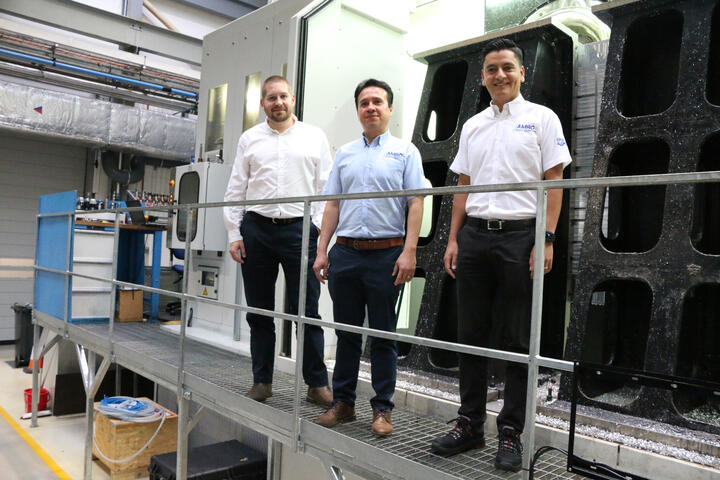Digital twin achieves UK-first for machine tool feedback control
27 October 2022A UK-first in digital twin technology research to develop autonomous, self-optimising subtractive processes for sustainable manufacturing has been achieved by research engineers at the University of Sheffield Advanced Manufacturing Research Centre (AMRC).
A team of AMRC experts have successfully produced a novel, real-time digital simulation model for feedback control of subtractive cutting operations as part of a technology portfolio related to online machining process simulation, monitoring and control.
Dr Rob Ward, AMRC industrial research fellow, believes that no-one in the UK has ever before achieved subtractive process closed loop control by real-time digital twins without the use of expensive sensors.
He said: “This is a huge step forward to being able to predict and anticipate part non-conformance on the production line and take restorative action before it occurs, reducing scrappage and rework and ultimately leading to more sustainable manufacturing processes.”
Dr Sabino Ayvar-Soberanis, AMRC technology fellow, says the project builds on the centre’s capabilities in virtual machining digital twin toolkits for future deployment in industrial settings.
He said: “This project has enabled us to prove the concept of a real-time adaptive control for subtractive process optimisation and it was the first time for both the AMRC and within the UK that a subtractive digital twin, with closed loop control using a complex online simulation, was implemented on a CNC machine platform.
“This is crucial within the subtractive sector to help achieve higher productivity, a reduction in costs and lessen the amount of tool chatter and the residual stress on structural components.”
The 12-month project, part of a digital subtractive programme of work funded through the High Value Manufacturing (HVM) Catapult, saw engineers undertake testing on a commercial computer numerical control (CNC) legacy machine tool capable of high-speed machining of aluminium - the same machine that makes wing ribs for the Airbus A350 XWB aircraft.
The testing was validated by a closed loop control system which could be implemented across various subtractive cutting processes, and included a novel online machining-induced residual stress control system, tool chatter detection and adaptive feed rate control.
The successful digital twin was demonstrated on a five-axis AMRC machine tool, used to machine large aluminium structural aerospace components.
Dr Javier Dominguez-Caballero, AMRC technical lead, says researchers worked in close collaboration with AMRC partners Siemens and Starrag UK on the project, fitting a Siemens Axis Data Stream (ADAS), monitoring system to output live data from the machine tool via a process fieldbus (PROFIBUS) digital communications system - and also to retrofit the CNC machine tool with fast analogue modules combined with synchronous actions - which is a special function within Siemens 840D machine controllers which enabled the team to create their own control algorithms.
“Thanks to the support of Siemens and Starrag UK, implementing both the modules and the ADAS monitoring system in our digital twin helped to present an important digital transformation from legacy systems of CNC machine tools to Industry 4.0,” said Dr Dominguez-Caballero.
“The success of our subtractive digital twin has relied on the complex implementation of the analytical closed loop simulation in an industry-relevant CNC machine platform.”
Dr Ward said that most factories in all sectors, from high-value aerospace and automotive to general engineering, still use legacy CNC machines, so being able to retrofit the technology onto existing machines allows manufacturers to get the most out of the resources they already have, without the need to invest in new machines.
He added that the outcome of the project demonstrated the success of the latest digital twin technology and proved its feasibility.
Dr Ward said: “Here at the AMRC we are integrating Industry 4.0 technologies such as high-speed process monitoring, artificial intelligence, cloud and edge computing, with world-class academic research in modelling of machining processes, real-time simulation and advanced closed-loop control to develop the next generation of subtractive process control for sustainable manufacturing."
“A huge part of sustainable manufacturing is using what you already have, getting the most out of your equipment and optimising the processes to be more efficient and economical.”
The team is now looking to develop the digital twin framework further and explore how it could work within other complex subtractive processes to enable a level of autonomy. Dr David Curtis, research and technology manager for the AMRC’s machining group, says progressing such digital subtractive research is critical for enabling sustainable and resilient supply chains.
AMRC continues to pioneer developments in the digital subtractive space, using mechanistic models for machining force simulation, coupled with stability mapping enabling tool path pre-processing for feed and speed optimisation. This optimisation capability is being delivered to market through Productive Machines, an AMRC spin-out company.
Dr Curtis says that Productive Machines’ solution represents a key step in enabling the wider digital transition across the subtractive sector.

